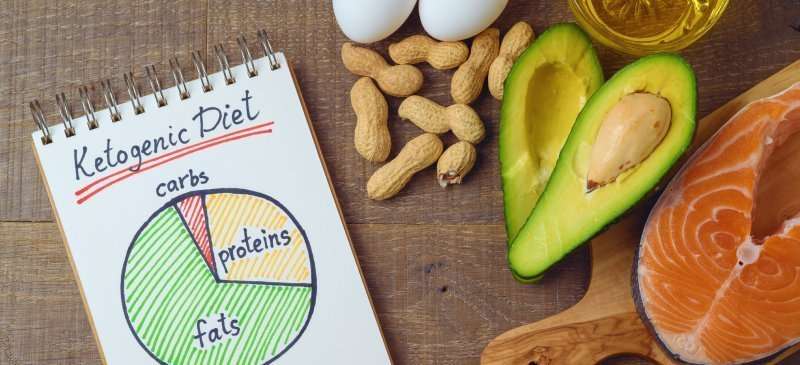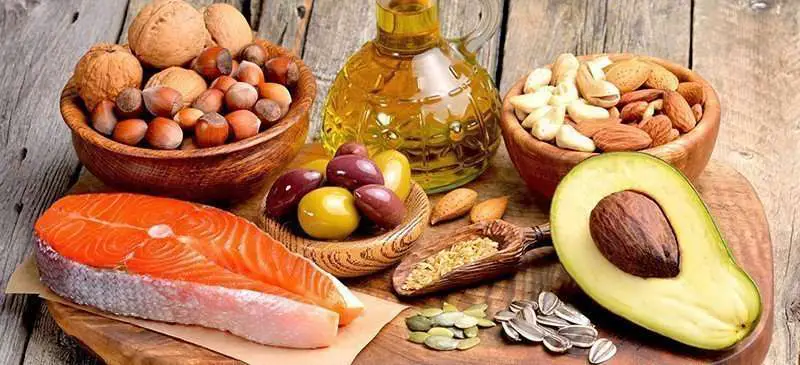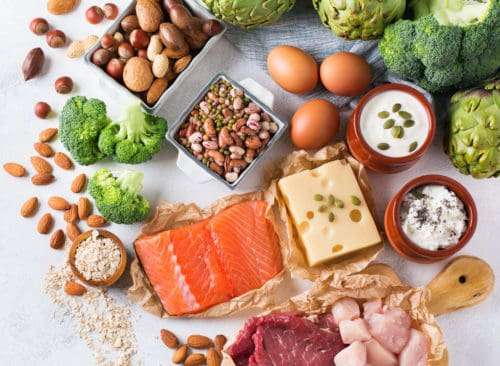The Ketogenic Diet and Flexible Dieting are some of the most popular diets on the internet for fitness enthusiasts. Both of these diets will get you to your fitness goals, and which (if either) diet is best is suited for you is often a matter of opinion. You will find hardcore supporters on either side of the keto vs. flexible dieting spectrum.
The Keto Diet focuses on eating minimal amounts of carbohydrates in order for your body to enter into the physical state of ‘ketosis’ (burns fat instead of carbs as its primary source of energy), leading to fat loss. Generally speaking, those on a ketogenic plan eat a high fat, moderate protein and low carb diet. Sounds pretty easy, unless you like bread, candy, ice cream, or any other high carbohydrate food. The results speak for themselves, however. Many people lose tons of weight on keto, and quick, too!
Flexible Dieting, on the other hand, is based around the amount of calories you eat and balancing the three key macronutrients (macros for short) into your overall caloric intake for the day. These three macros are: fats, carbohydrates, and proteins. When you flexible diet, you can eat whatever you want, provided you are staying at or near your daily caloric intake while mashing in the correct amount of macros, based on a ratio’d percentage. This approach is similar to keto, but with an emphasis on protein and carbs over fat intake. Flexible dieters often take longer to see dramatic changes in body composition, but they don’t have to cut out large groups of food to do so.
In this article, I will break down the differences between the Keto Diet and Flexible Dieting so that you can decide if either is suited for you:
The Ketogenic Diet
The Ketogenic diet is a high fat, moderate protein, minimal carb diet. It was originally developed as a way to reduce seizures in epileptics, but has morphed into a dietary phenomena over the past few years.

Your body traditionally fuels itself through glucose (sugar) which generally comes from carbohydrates. However, this diet forces your liver to produce “ketones” from fat cells. Ketones are an alternate fuel source for your body, produced by the liver when blood sugar (glucose) is low. When you are in ‘ketosis,’ your body burns fat instead of glucose for fuel.
The upside to this is that these ketones are far more ‘potent’ than traditional glucose is. Energy goes through the roof while people report much better mental clarity, deeper sleep, and clearer skin.
How to Keto
The most important factor to enter a state of ketosis is to not eat too many carbohydrates. Since carbs can quickly turn into blood glucose, too many carbohydrates can stop the production of ketones, and force a (painful) exit from ketosis.
Ideally, you want to stay below 50 carbs a day in order to support entering a state of ketosis, and remaining there until you reach your goals. Therefore, you want to stick with low carb foods like cheese, pork, red meat, chicken, leafy green vegetables, almonds, avocados, and greek yogurt. Here are some example recipes.
What not to eat on keto
While on keto you want to avoid carb heavy foods while limiting sugar intake. Generally, you want to keep away from the following:
- Bread
- Pasta/noodles
- Processed food (fast food included)
- Vegetables that grow below ground
- Potatoes
- Yams
- Carrots
- Large fruits (generally, anything larger than a berry)
- Processed sugars
- Beer
- Soda
It’s probably best to stay away if…
People who are pregnant and people who are diabetic should not follow Keto. As always, please ask your doctor first before starting any diet.
Keto in a nutshell
- Burns fat for fuel
- High-fat, moderate-protein, low-carb
- Minimal amounts of carb
- Avoid sugars
- Quick weight loss
If you decide to join the keto wagon and find yourself suffering from a lack of focus or energy while exercising, you might want to check our our tips to improve performance.
Need some help?
Shape Success, Live Exceptionally
Hit that button, and get started today.
Flexible Dieting
Flexible Dieting is more of a way of eating than a rigid, highly regimented diet. Macro dieting allows you to eat anything you want as long as you are meeting your daily macro requirements while staying within your caloric intake.
This diet is the harder of the two to master, admittedly. One too many pieces of pizza or an extra handful of almonds can easily put you over your fat intake for the day, for example. However, there is an old saying that goes something like: ‘with great power, comes great responsibility’—you need to hit your macros. This is still a “diet” after all! Generally speaking can’t change your body composition for the better if you are eating fast food and candy all the time!
Where they differ, however, is that unlike the ketogenic diet, flexible dieting focuses more on eating protein and carbs over fats, with the emphasis on proteins.

Macro dieting is about prioritizing healthy foods as well as honoring your sweet tooth. You can have it both ways….as long as it fits your macros. Yes, you read that right. If you follow this diet, you CAN have a slice of pizza AND a slice of cheesecake for dinner IF you can fit it within your macro ratio/caloric goals. That very idea makes flex dieting ideal for people who don’t want to give up desert, candy, or breads.
Pro tip: If you need help finding what ratio of macros you should follow or tracking your intake, apps like MyFitnessPal come in handy. It is actually an incredibly popular app, regardless of what plan you are subscribed to for your diet.
How to flexible diet: a step by step guide
- Figure out your daily caloric needs by calculating your TDEE.
- Decide on a good ratio for your macros.
- Plan out your diet accordingly
- Figure out what “macro-friendly” foods you like
- Build out a meal plan that allows you to hit your required macro/calorie ratio
- Stick within that ratio!
- Adjust as necessary when you reach your goals, or aren’t seeing the results you want.
Most flexible dieters have little to no impact on their every day lives once they get into the habit of tracking macros. They can still modify their body composition over time, without always skipping dinner with friends. Additionally, the relative ‘slowness’ of flexible dieting and the ability to eat what you want generally helps keep the weight off for a longer period of time than most other diets if you should wander off of the diet.
Tips for Flexible Dieting
- Calculating macros requires a little more planning, but can be easier to maintain because you don’t *have* to give up entire categories of foods or nutrients for weight loss
- If you know you are going to have a “cheat meal” (or a meal that will expend more macros), that is fine. Make up for it the next day. Flexible dieters generally track their diets over the week, not daily. Just make sure that you stay within the boundaries at least 80% of the time.
- Be careful—nothing ruins flexible dieting quicker then enjoying too much cake/candy/pizza/etc.
Overview
- Eat within your macros/calorie requirements
- Enjoy the foods you like in moderation
- Problematic if left uncontrolled
- Slower, easier to keep desired body composition over time
Decisions, Decisions, Decisions
How you diet really comes down to your goals and how restrictive you want your diet to be. Both of these lifestyles are effective if done properly, however, each has their own advantages and disadvantages:
Keto is useful for weight loss because it uses fat as your body’s fuel source. This drastically reduces fat stores throughout the body quickly as it seeks out energy. However, it is very restrictive since you can’t eat too many carbohydrates each day and such a small intake may have some negative effects on your body.
Flexible dieting doesn’t restrict you to certain kinds of food, so you don’t suffer from FOMO (Fear of missing out). This is great when you see a cheesecake at dinner or a delicious loaf of bread in the store. You just have to be careful not to over indulge on your macros. Additionally, while showing slower results, the diet has been shown to be far more sustainable over time and at keeping the weight off/on.
Regardless of if you decide to go with either of these diets, remember: If you go out on a Saturday night with friends, enjoy! Do your best to stick with it, but if you fall off the wagon, get back on in the morning and keep chugging along. Stick with whatever you choose the overwhelming majority of the time. A cheat MEAL isn’t dangerous. A cheat week is disastrous.
At the end of the day, we are all trying to get in better shape. Dieting is a key component to achieving our goals. No matter how we choose to fuel ourselves, we need to stick to it for any noticeable changes to happen. Casual dieting does just as much as most fad diets do. Nothing good.
Let Us help You Out
At CONDITIONerd we are here to help you achieve better physical and mental health through exercise. Check out the plans we offer to our customers and see if you could benefit from working with our team. And if you have questions, you can always contact a CONDITIONerd team member.
Personal trainers, like those found here, can help guide you on your pathway towards reaching your fitness goals, whether that is getting bigger, stronger, faster, more lean, or just generally feeling better.
We can get you setup with a periodized workout plan, supplement information, and advice on nutrition to help you reach your goals.
The only thing you need is some motivation and a willingness to change some old habits.
Get into contact with us to find out what membership is right for you. In a CONDITIONerd program, you’ll be surrounded by others who can help you to get where you want to be.
Generally, our clients start to see some pretty awesome changes in 2-3 months time, some sooner.

